Key takeaways:
- Effective funding pitches combine a compelling narrative with emotional engagement, allowing entrepreneurs to connect with investors beyond just numbers.
- Thorough preparation is essential, including practicing delivery and seeking feedback, which enhances confidence and sharpens the message.
- Identifying and researching target investors helps in crafting tailored pitches that resonate with their values and previous interests.
- Incorporating storytelling elements and visual aids in pitch decks can transform presentations from one-sided to engaging, creating a collaborative atmosphere.
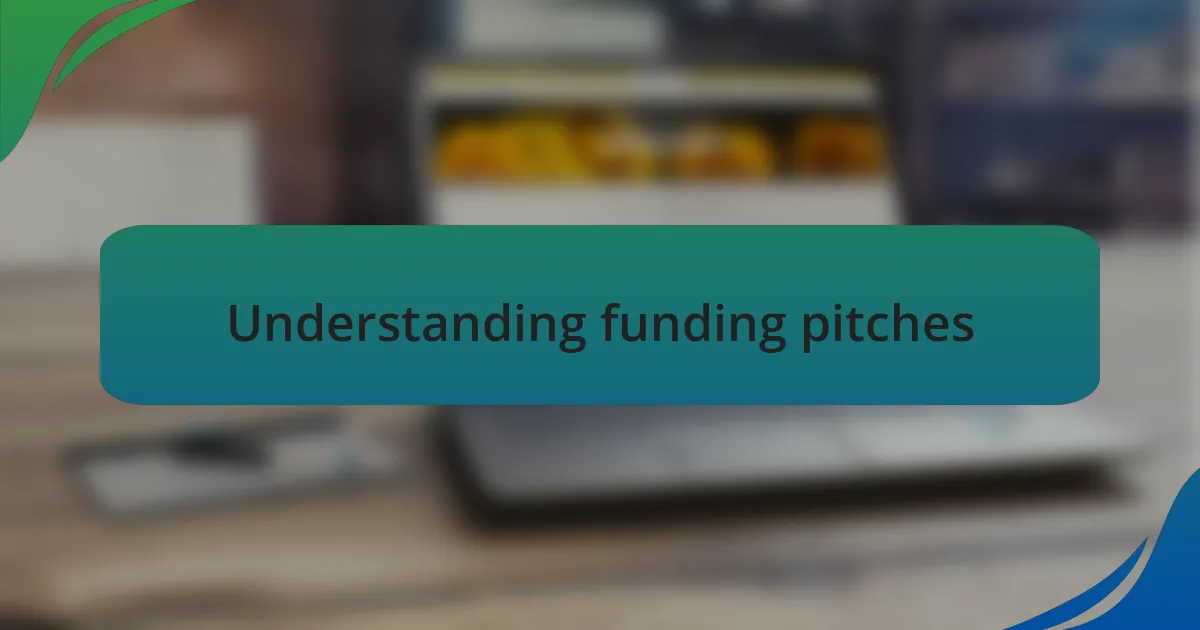
Understanding funding pitches
Understanding funding pitches is crucial for any entrepreneur seeking to grow their business. When I prepared for my first pitch, I realized that it wasn’t just about presenting numbers and projections. It was about telling a compelling story that connects with the investor on an emotional level. How can you expect someone to believe in your vision if you don’t share the passion behind it?
In my experience, the most effective pitches highlight not just the business model, but also the problem it seeks to solve. I recall a moment when I shared a personal story of how my product made a significant difference in someone’s life; I could see the shift in the room. Investors appreciate authenticity, and infusing emotion into your presentation can draw them in. Have you ever felt connected to a cause? That’s the effect your story can have.
Timing is just as important as content. I distinctly remember rehearsing until my pitch flowed seamlessly, allowing me to engage with the audience rather than just reciting facts. Remember, it’s a dialogue, not a monologue! By inviting questions and addressing concerns during your pitch, you transform a formal presentation into a collaborative discussion that leaves a lasting impression.

Importance of preparation
Preparation for a funding pitch is essential because it lays the groundwork for everything that follows. I learned this firsthand when I spent hours organizing my thoughts and outlining key points. By ensuring I was thoroughly prepared, I could anticipate questions and counter potential objections, which ultimately made me feel far more confident when presenting. Have you ever walked into a situation unprepared and felt that sinking feeling? It’s not a great place to be.
When I think back to my preparation process, it’s clear that the smallest details matter just as much as the main content. For instance, practicing in front of friends allowed me to refine my delivery and gain insight into their reactions. They pointed out areas where I seemed nervous, which helped me work on my body language and tone. This kind of feedback was invaluable. How often do we overlook the power of outside perspectives in refining our message?
Moreover, preparation goes beyond just knowing your material; it’s about embodying your vision. I vividly remember spending time visualizing the kind of impact my business could have. This mental practice fueled my passion during the pitch and made the entire experience more engaging. When you truly believe in what you’re presenting, it reverberates through your words and demeanor. Isn’t it fascinating how that energy can transform a simple presentation into a heartfelt conversation?
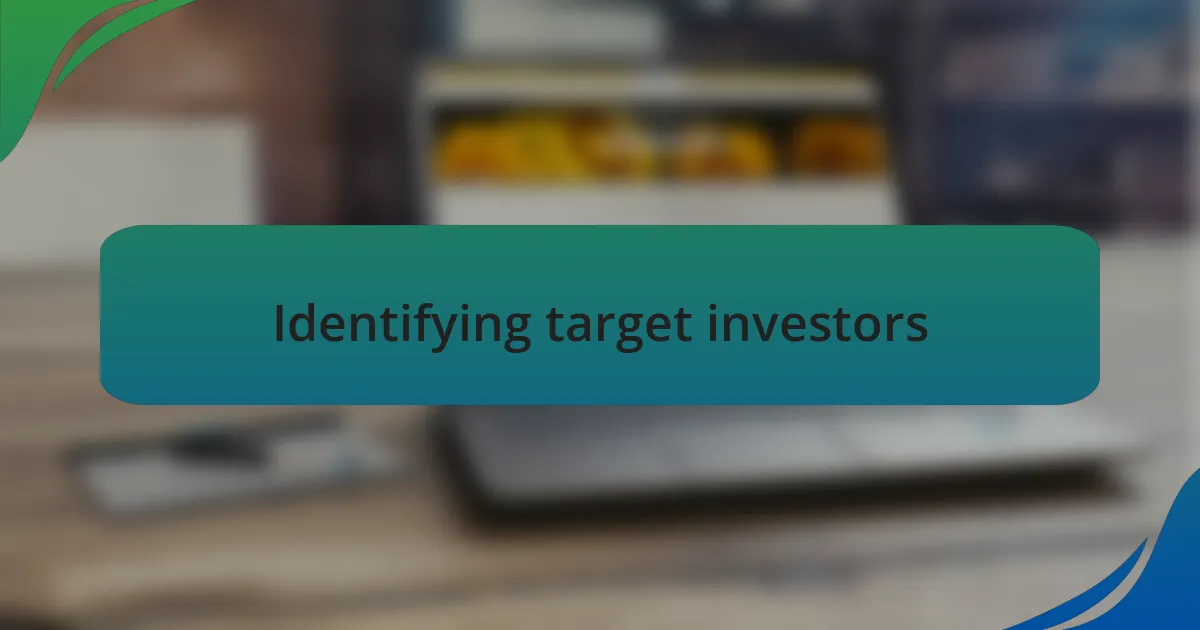
Identifying target investors
Identifying target investors is a crucial step that can significantly influence the success of your funding pitch. In my experience, it was about matching my vision with investors who shared similar values and objectives. For instance, when I first started reaching out, I made a list of potential investors that had a history of supporting businesses in my industry; this narrowed my focus and increased the chances of receiving meaningful feedback. Have you taken the time to research the backgrounds of your potential backers?
Once I identified a few key players, I dived deeper into their interests and recent investments. I found that looking into their previous funding rounds provided insight into what they were passionate about. One particular investor’s commitment to sustainability resonated with the environmental initiatives of my business. It made me realize how critical it is to connect my pitch to an investor’s prior engagements. How would you feel if you could present a genuinely tailored approach that speaks directly to an investor’s heart?
Creating a profile for each prospective investor helped me craft personalized messages that showcased not only what I needed but also how I could align with their goals. I remember drafting a message that referenced a recent project the investor had backed, illustrating how my business could complement their existing portfolio. This approach made my outreach feel more authentic and thoughtful, traits that I know many investors appreciate. How can you ensure your pitch resonates with each potential investor on a personal level?
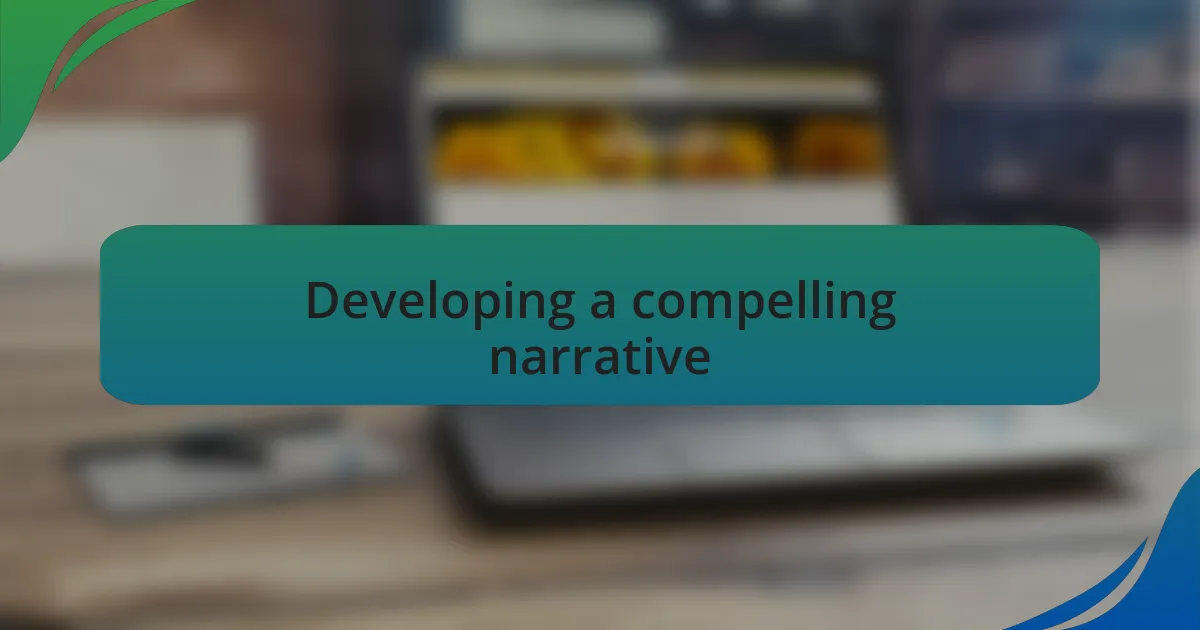
Developing a compelling narrative
When it came time to develop a compelling narrative for my funding pitch, I knew storytelling would be a key element. I reflected on my journey, the obstacles I faced, and how they shaped my business vision. For example, I often shared a moment early in my startup days when a critical failure almost ended my venture; instead, it fueled my determination to innovate and adapt. That raw, personal touch made my story relatable and engaging.
I realized that weaving data and personal anecdotes together created a more powerful narrative. By illustrating my business’s impact with hard numbers while simultaneously sharing impactful stories of customers I’ve helped, I painted a holistic picture of success. Have you ever experienced the moment when a statistic suddenly becomes more meaningful because of a personal story? That’s the magic of combining facts with passion.
Moreover, I always kept my audience’s perspective in mind. I aimed to answer the “why” behind my business—why this venture matters to me, why it would resonate with them, and why it could succeed. This approach helped me craft a narrative that was not only convincing but made my audience feel like they were part of my journey. How would it feel to have your investors emotionally invested in your story?
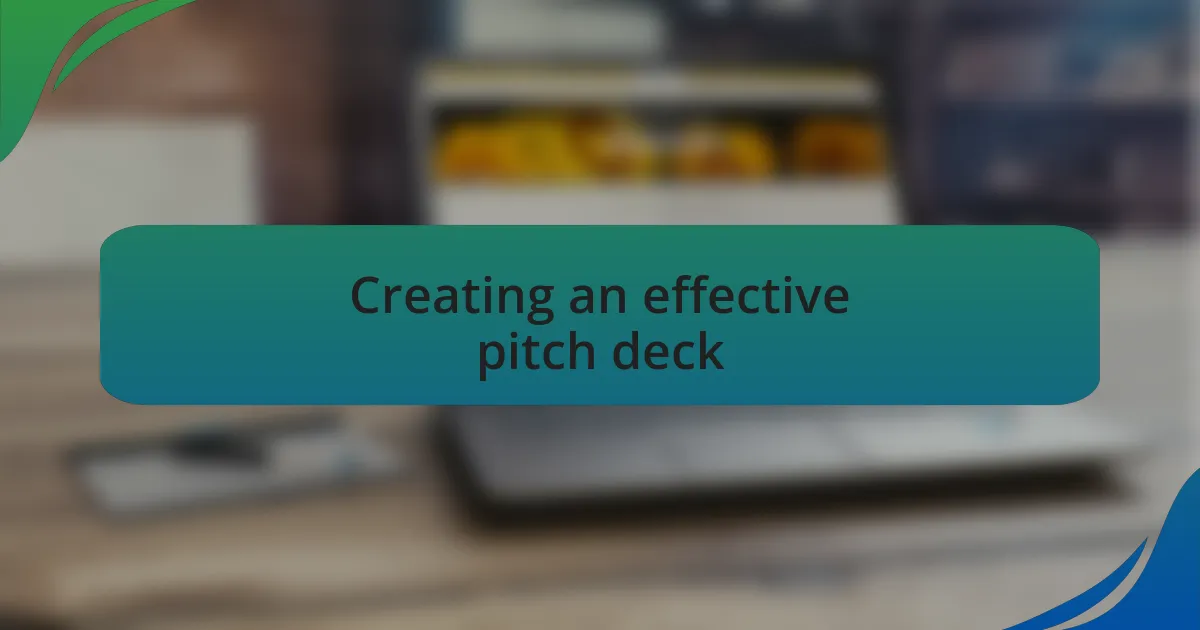
Creating an effective pitch deck
When I set out to create my pitch deck, I focused on clarity and visual appeal. I remember sitting down with a blank slide and realizing that less is often more. By limiting each slide to essential information and impactful visuals, I could convey my message without overwhelming my audience. Have you ever found that a simple graph or image can resonate more than lengthy text? I certainly have.
The structure of my deck played a vital role in capturing attention right from the start. I began with a strong hook that outlined the problem my business aimed to solve. This immediate engagement is crucial—investors need to see the challenge before they can appreciate the solution. I vividly recall presenting my stats on market demand and customer pain points; the room felt charged with interest, as if my passion was infectious.
To further enhance engagement, I incorporated storytelling elements into my slides. Instead of just listing features, I showcased customer testimonials that illustrated real-world impacts of my product. I still hear the applause when I displayed a video clip of my customer praising our service, and I believe this approach turned theoretical benefits into tangible outcomes. How powerful is it to witness the very people who benefit from your vision? It transformed the pitch into a collaborative dialogue rather than a one-sided presentation.

Practicing delivery techniques
Practicing my delivery techniques was a game-changer in preparing for my funding pitch. I remember spending hours in front of the mirror, rehearsing my main points and refining my body language. Each time I spoke aloud, I noticed how my confidence grew, and I started to feel the energy of the words in my own body. Have you ever felt the difference between reading something quietly and expressing it with conviction? That practice made me realize the power of vocal tone and pacing.
I also recorded myself during practice sessions to critique my delivery. Watching the playback was eye-opening; I could see the moments where I fumbled or looked disengaged. By addressing those areas, I fine-tuned my presentation to hold attention, with dynamic delivery that mirrored my passion. This process allowed me to identify how a pause can build suspense or how a smile can invite connection. I still recall the surprised look on my friend’s face when I transformed a mediocre practice run into a more compelling performance after just a few tweaks.
Engaging friends or family for mock pitches was another effective strategy I used. Their questions often caught me off guard, which pushed me to think on my feet and respond more fluidly. I approached these sessions as a collaboration, where each piece of feedback strengthened my narrative. Those exchanges were priceless; they not only helped me perfect my pitch but also reminded me of the human element in seeking support. Doesn’t it feel different when you’re not just presenting to an audience, but engaging in a conversation? That’s the kind of connection I aimed to create during my actual pitch.
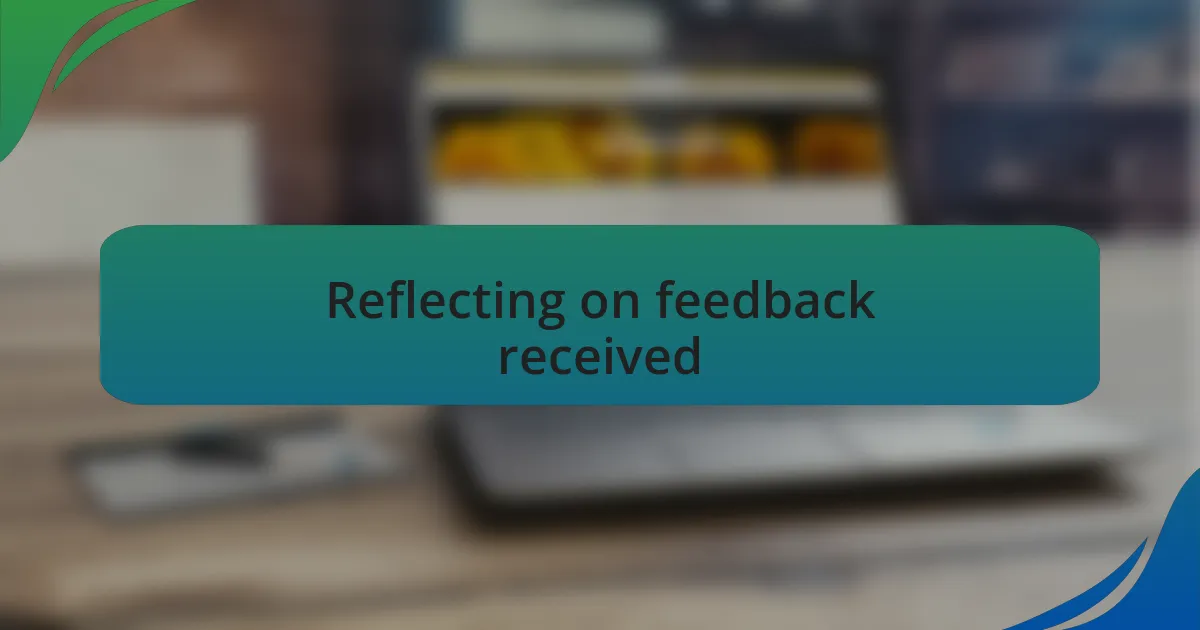
Reflecting on feedback received
Receiving feedback on my pitch was an enlightening experience. After a few practice sessions, I sought out honest opinions from trusted colleagues who weren’t afraid to challenge my ideas. I vividly remember one of them saying, “Your numbers don’t tell the whole story.” It struck me—what good are figures if they don’t resonate emotionally? This moment pushed me to weave a narrative around the data, ensuring my pitch wouldn’t just inform but also inspire.
I found that reflecting on the critiques helped me cultivate a growth mindset. Rather than feeling defensive, I embraced the suggestions, particularly one that suggested I share a personal story about my journey. This made me realize that vulnerability can create a deeper connection with the audience. Have you ever shared something personal that changed the way people perceived your message? I certainly did, and it transformed my pitch from a simple presentation into a heartfelt conversation.
Some feedback challenged my assumptions, prompting me to rethink aspects I was confident about. I remember an instance when one observer pointed out that my value proposition wasn’t clear enough. Initially, I brushed it aside, thinking I had articulated it well. But as I reflected, I recognized that their perspective was invaluable. It served as a reminder that effective communication is ultimately about clarity. Isn’t it fascinating how fresh eyes can identify blind spots that we overlook?